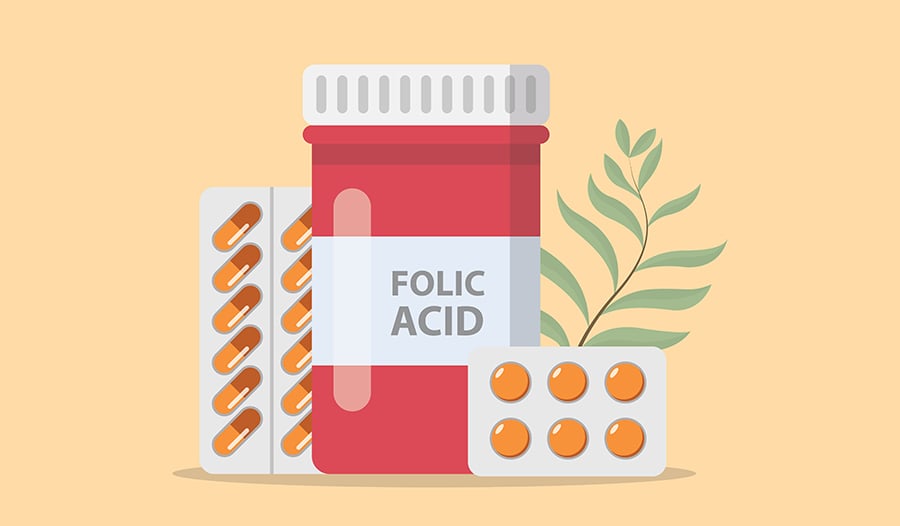Preventing Folic Acid Deficiency: Boosting Health for a Healthy Pregnancy
DISCLAIMER:This blog does not intend to provide diagnosis...
- In this article:
- What Is Folic Acid?
- Difference Between Folate and Folic Acid
- What Does Folic Acid Do In the Body?
- Food Sources of Folic Acid
- Why Does Folate Deficiency Occur?
- The Importance of Folic Acid in Pregnancy
- Folic Acid Dosage
- How to Prevent Folic Acid Deficiency

What Is Folic Acid?
Folic acid, also known as folate or vitamin B9, is a well-known water-soluble vitamin.
Already these words – "water-soluble vitamin" allow us to draw two important conclusions:
- The human body cannot synthesize folic acid and needs to get it from food constantly (that's why it is a vitamin).
- The water-solubility of folic acid prevents us from building up a stockpile of it in the body – so, folic acid must be present in the human diet at all times to maintain health.
Difference Between Folate and Folic Acid
Although the words "folate" and "folic acid" are almost always regarded as synonyms, there is a small, not always obvious, and not particularly fundamental difference: "folate" usually implies the natural origin of the substance. In contrast, "folic acid" implies industrial production.
What Does Folic Acid Do In the Body?
Folic acid ensures the processes of cell division, participates in protein synthesis, and is an essential factor that ensures the normal functioning of the hematopoietic system.
Not surprisingly, folic acid hypovitaminosis (deficiency) is associated with a wide variety of health problems in both adults and children. The most common problem is the development of a special form of anemia, in which the size of red blood cells – erythrocytes – changes: they become abnormally large and cannot fully perform their functions related to the transportation of oxygen and carbon dioxide. Consequently, numerous symptoms are caused by anemia – weakness, shortness of breath, heart palpitations, and pale skin.
Food Sources of Folic Acid
Folate, in sufficient quantities to meet human needs, is present in many foods of both plant and animal origin. The main food source of folate is green leafy vegetables.
Folate is abundant in spinach, asparagus, lettuce, broccoli, and cabbage (both white and cauliflower) and in legumes – peanuts, lentils, chickpeas, and soybeans. Raw peanuts are a champion – they contain almost twice as much folate as spinach.
Continuing the list of excellent plant sources of folic acid, we cannot fail to mention sunflower seeds, nuts, red peppers, avocados, beets, bananas, cereals, and fruits. Bread and potatoes also play an important role in meeting our folate needs.
Among animal products, the leaders in folate content are meat by-products (especially liver), eggs, fish, and meat. In whole milk, there is not much folate, but the preparation of yogurt increases this amount by two times, and in some varieties of cheese, folic acid is 10-12 times more than the same amount of milk.
Why Does Folate Deficiency Occur?
At first glance, folic acid hypovitaminosis is unlikely, as there is a fairly large list of inexpensive and accessible foods containing enough folate to prevent deficiency.
However, there are a number of factors we must consider:
- Folic acid is destroyed by heat, so cooking foods can reduce folate by 80-90%.
- Folic acid is soluble in water. Unsurprisingly, when cooked (especially when the water is poured out at the end of cooking), there is almost no folate left in the finished product.
- Certain physiologic conditions of the human body - especially pregnancy and breastfeeding - significantly increase the need for folic acid, and the diet often fails to keep up with these increased needs.
- Folic acid deficiency is typical for a number of diseases. This is possible in bleeding inflammatory diseases of the liver and kidneys. Hypovitaminosis often leads to the impaired absorption of vitamins, especially in inflammatory diseases of the small intestine, as well as possible congenital conditions characterized by impaired absorption of folic acid. A frequent cause of hypovitaminosis in adults – alcohol abuse.
- The activity of folic acid can be reduced by certain medications – anticonvulsants, diuretics, some contraceptives, drugs used to treat diabetes, inflammatory diseases, and cancer.
The Importance of Folic Acid in Pregnancy
Folic acid ensures cell division processes and participates in protein synthesis. It is obvious that the more active the processes of cell division occur in the body, the higher the need for folic acid. This is the reason for the special role of folate during pregnancy.
Still, this role has a very specific nuance: for the successful realization of physiological effects, it is very important that at the stage of conception (immediately after which the process of active cell division will begin) in the woman's body, there is no deficiency of folic acid.
Numerous studies have shown conclusively that folic acid deficiency before or during pregnancy multiplies the likelihood of severe neural malformations in the fetus.
Therefore, folic acid supplementation at a dose of 0.4 mg (400 mcg) per day is strongly recommended for all women of childbearing age, especially those planning pregnancy and pregnant women.
The most significant period of time, when it is especially important to avoid folate deficiency, is considered to be from one month before conception to 12 weeks of pregnancy. Nevertheless, it is advisable to start taking folic acid preparations 3 months before the planned pregnancy and continue throughout the pregnancy and subsequent breastfeeding.
Folic Acid Dosage
There is no clear, unified, and universally accepted answer to the question: "How much folic acid should I get daily to prevent problems?". However, most respected national and international recommendations give very definite figures.
But before we familiarize ourselves with these figures, let's clarify a very important point. There is a fairly significant difference between how food folate is absorbed and how folic acid preparations (drugs, supplements) are absorbed. Food folate absorption is about 50%, while folic acid absorption is much higher and almost always exceeds 85%.
To account for this significant difference, scientists have proposed a special unit of measurement - DFE - dietary folate equivalent.
1 mcg of folate in food is 1 DFE, but 1 mcg of folic acid is 1.7 DFE. These proportions are the basis for all subsequent calculations. If, for example, the daily requirement is estimated at 600 mcg of dietary folate (600 DFE), this would correspond to about 353 mcg of folic acid (600:1.7).
Note that folic acid intake rates for children in the first year of life are still a subject of research and ongoing debate.
The recommended daily dietary allowances of folate depending on age in mcg (1 mcg = 1 DFE) are as follows
- 1 - 3 years - 150 mcg
- 4 - 8 years - 200 mcg
- 9 - 13 years - 300 mcg
- Over 14 years old - 400 mcg
- Pregnant women - 600 mcg
- Breastfeeding women - 500 mcg
How to Prevent Folic Acid Deficiency
The preventive use of folic acid is especially important just before conception. However, predicting the timing of conception can be an inaccurate and thankless task.
Not surprisingly, many countries are implementing a program of enrichment of products - primarily rice, flour (wheat, corn), and milk – with folic acid, and this practice shows excellent results, as it significantly reduces the number of children born with nervous system malformations.
Widespread and generally accepted recommendations on rational nutrition promoting food diversity with emphasis on fruits and vegetables – in turn, prevent folic acid hypovitaminosis, and these recommendations are applicable regardless of gender and age.
Tips for proper cooking allow you to preserve a significant amount of dietary folate. In particular, it is recommended to use steamers and microwave ovens as an alternative to conventional cooking of food with subsequent removal of water.
Folic acid is a frequent component of most multivitamins and an essential, mandatory component of vitamin and mineral preparations used by women during pregnancy and lactation.
It is important to realize that pregnancy planning and medical support at the pregnancy planning stage are the most important elements of informed care for the health of the mother and child.
Is your family planning a pregnancy? If so, you have much to discuss with your doctor: lifestyle, immunizations, dental health, pets, bad habits, medication use, and much more! And it will be just fine, wise, and right if you meet with your doctor three months before the planned conception and choose a folic acid preparation for prophylactic intake together!
References:
- https://ods.od.nih.gov/factsheets/folate-HealthProfessional/
- https://ods.od.nih.gov/pdf/factsheets/folate-consumer.pdf
- https://www.mayoclinic.org/drugs-supplements-folate/art-20364625
- https://www.govinfo.gov/content/pkg/FR-1996-03-05/pdf/96-5014.pdf
- https://medlineplus.gov/folicacid.html
- https://www.fda.gov/media/139471/download

 By Dr. Evgeniy Komarovsky, M.D.
By Dr. Evgeniy Komarovsky, M.D.


